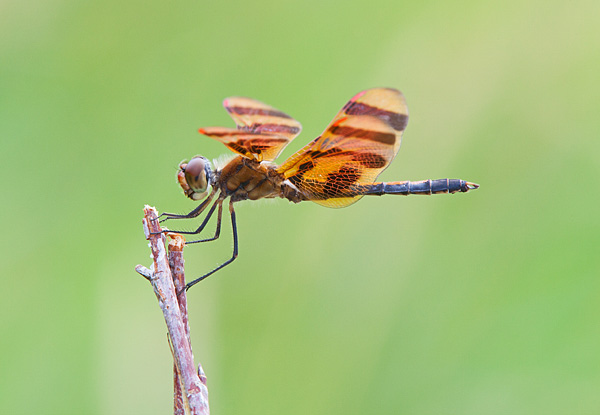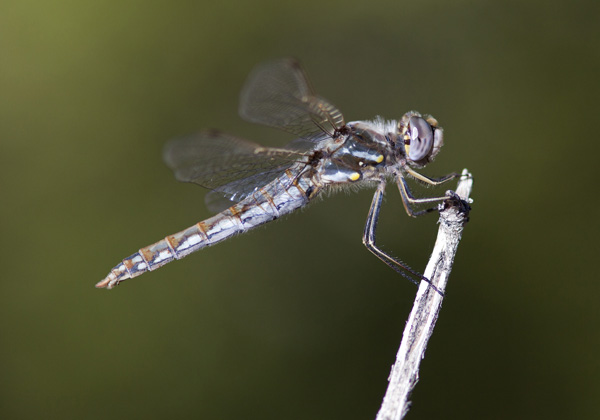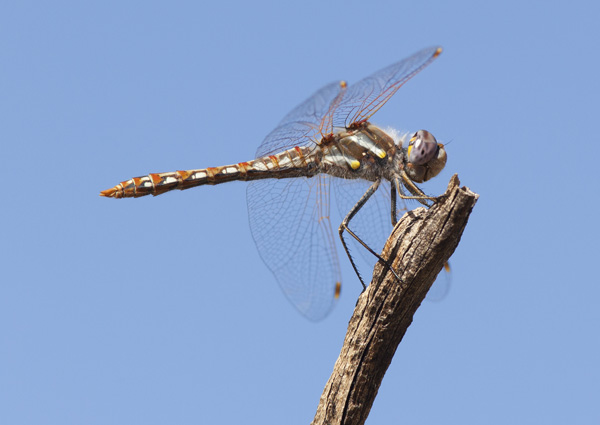This is a guest post by the PhotoNaturalist, Steve Berardi. Check out his amazing guides on outdoor and nature photography.
Dragonflies are some of the most interesting insects found in nature. They may not look too interesting from far away, but if you look a little closer, you'll see that they have some pretty incredible colors.
Unfortunately, sometimes it can be frustrating to photograph them. They get scared easily, and it's a constant battle to get the entire dragonfly sharp in your photos. But, here are a few tips for dealing with these problems:
#1 – Use a tripod, but keep the head loose
Dragonflies are almost always on the move, so you'll rarely have time to completely setup your tripod, lock in the ballhead and snap a few shots. But, you can still use your tripod for some stability by leaving the ballhead loose. This way, you can quickly point your camera in a new direction if the dragonfly moves to another perch or you spot a better one to photograph.
#2 – Use a small aperture
One of the most difficult parts of photographing dragonflies is getting their entire body in sharp focus. But, an easy way to battle this is to use a fairly small aperture. Typically, f/11 or f/16 works well.

#3 – Wait until they're front-lit by the sun
Front-lighting will make exposure easier because it will evenly light the dragonfly. Side-lighting can be a disaster because it often creates harsh shadows on your subject. And, backlighting often creates flares.
#4 – Don't cast your shadow on them
Dragonflies love the sun, so a sure way to scare them is to cast a shadow on them. Be careful not to do this while you're approaching them and setting up your shot.

#5 – Wait for a partly cloudy day
Dragonflies are most active when the sun is shining, but when the sun is behind some clouds it helps diffuse the light, making those colors of the dragonfly really “pop.” The benefit of photographing dragonflies when it's partly cloudy is that you catch them when they're most active AND when you'll have the best lighting to photograph them.
#6 – Position your camera so its sensor is parallel to the dragonfly
You only get one plane of complete sharpness, so you'll want to put as much of the dragonfly in this plane as possible. That means positioning your camera so its sensor is parallel to their long body (or the surface of their wings if you're photographing them from above).
#7 – Wait for the dragonfly to return if you scare it
Most dragonflies will find a perch they like, and stick to it as long as they can. So, if you accidentally scare away a dragonfly by getting too close or casting a shadow on it, just sit and wait awhile. That dragonfly will likely come back to the same perch within 10-15 minutes.

#8 – Use a fast shutter speed
Since you won't have time to lock in the ballhead on your tripod, it's helpful to use a fast shutter speed to increase your chances of getting a sharp photo. To get that faster shutter speed, try increasing your ISO to 400 or even 800.
Steve Berardi is a nature photographer and software developer. You can read more of his articles on nature photography at the PhotoNaturalist and pick up a free guide on photographing dragonflies.





19 Comments
Great article :)!
Here my two best attempts of shooting to dragonflies:
Sorry. The links were these:
https://2.bp.blogspot.com/-LeStp41-C9M/TiR20HyW_lI/AAAAAAAADgI/z2kesukur4I/s1600/9366+-+libelula+para+lvs.jpg
https://farm7.static.flickr.com/6144/5937614507_f7c562a1f7_b.jpg
Dude, that first one is amazing… I literally said “Wow!”… Love the great blue background too…
Thank you very much :)! This dragonfly’s picture was “easy” to take because the bug was big and it was immobile :).
I shot a dragonfly on Cape Tribulation Australia. Crept at a snails pace for about 5 mins to get close enough, I just used a Canon S95, no macro lens. I had to get within 20cm to get this shot!
https://lh4.googleusercontent.com/-2OrBjsyjCt4/TcdUqZP760I/AAAAAAAABv8/DUTP0eeLrYc/s1024/IMG_0702.jpg
Thank you for sharing these tips. I’ve been trying to photograph dragonflies with little success. Butterflies are easier.
Catching ’em pirched is fine, but catching ’em in flight. Now, that’s the challenge. Any suggestions?
The advise about waiting for dragonflies to return to their preferred perch is probably the most useful. It helps to observe 1 or 2 at a time and follow them until you see where it is they like to rest and then go to that spot and wait for the next time they take a rest. I also found that using a telephoto helps out because it allows you to be less obtrusive of their space and seem less threatening to them. I was able to take the below picture using this method.
https://www.flickr.com/photos/emantable/5868294216/
Sorry…here is the photo. And in case the image link is broken again here is the link https://www.flickr.com/photos/emantable/5868294216/
I shot this over the weekend. He stayed very still for me. My enemy was the breeze.
I liked the idea of keeping the aperture smaller to get the dragonfly in focus. There is a one flip side to this though – we might not get a shallow DoF.
This is my trial at capturing dragonfly with my Canon SX120 IS.
https://www.flickr.com/photos/rockingrave/5183516743/in/photostream
I wonder only that the aperture size.
I photograph dragonflies aperture F22, and dragonflies are sharp enough. Why should I use a smaller spout?
[url=https://www.flickr.com/photos/47342791@N03/6011187903/]https://farm7.static.flickr.com/6146/6011187903_dbdf078313.jpg[/url]
[url=https://www.flickr.com/photos/47342791@N03/6011187903/]DragonFly[/url] by [url=https://www.flickr.com/people/47342791@N03/]Jussi’s Images[/url], on Flickr
I photograph dragonflies Extension Tube, and usually I use a loophole in the F22 or F26. So why should I use a smaller aperture?
[url=https://www.flickr.com/photos/47342791@N03/6011187903/]https://farm7.static.flickr.com/6146/6011187903_dbdf078313.jpg[/url]
[url=https://www.flickr.com/photos/47342791@N03/6011187903/]DragonFly[/url] by [url=https://www.flickr.com/people/47342791@N03/]Jussi’s Images[/url], on Flickr
I photograph dragonflies Extension Tube, and usually I use a loophole in the F22 or F26. So why should I use a smaller aperture?
Sorry, heres mine dragonfly
And here you can find some more…
When I spot the heading, I was really looking forward to learn some dragonfly-specific tricks . However, I find this article rather trivial, most of the advices are very general and hold for any kind of photography.
Nevertheless, here go my few comments:
ad #1: monopod works even better
ad #2: I do not, I rather give up sharpness of wing tips as I do not like messy BG resulting from deeper DOF. Of course, if BG is far enough, small aperture is a good idea.
ad #3-5: direct sunlight is OK from every angle if you know how to set up a camera. Indeed for faithful colors a diffused light works better. ad #3 Direct front-lit sun makes unavoidable reflections on dragonfly’s eyes which then turn quite ugly on a photo.
ad #7: depends on a particular species. Some come back in a minute, others never.
some dragonflies too
https://www.flickr.com/photos/38699212@N08/4554928658/